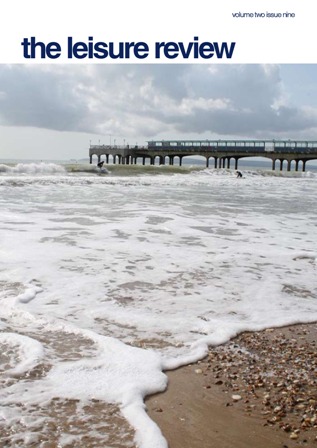Waiting for the new wave
Work underway on the regeneration of Boscombe
New break for Bournemouth
There are four artificial surf reefs in the world and one of them is in Bournemouth. Jonathan Ives strolled between the piers to find out how you make a surfable wave and what it might mean for the area’s tourism offer.
Waiting for the new wave
Work underway on the regeneration of Boscombe
On the beach not far from Boscombe pier there is a huge pile of sand surrounded by temporary fencing. Even with the warning notices it doesn’t look much like a major construction site, much less the focal point of a multi-million-pound regeneration scheme. But looks can be deceiving: this is the home of the Bournemouth surf reef and regeneration focal point is exactly what it is.
The theory behind the surf reef project is fairly straightforward. A man-made barrier is anchored off shore to alter the shape of the seabed. This then affects the movement of water and alters the pattern of the breaking waves. When sea conditions are favourable the reef creates a larger wave, improving the quality of the wave for surfers and increasing the number of surfable days during the year. However, the practical aspect of the project is rather more complex than the theory. In addition to detailed environmental modelling, impact assessments and design, the preparation required extensive consultation with Defra and local communities to achieve the appropriate licences and permissions. Installation involves the anchoring of a one hectare geo-mat to the sea bed some 250m from the beach, the fixing of 55 enormous bags to this base and then the pumping of thousands of tonnes of sand into each bag. And the sand has to be filtered before it is pumped.
As one might expect, such technology and expertise does not come cheap. Constructing the reef is costing Bournemouth £2.7 million and the council has committed an overall total of £9.6 million to the Boscombe Spa regeneration fund. All of which prompts the question: what does one get for one’s money? The answer lies in the value of urban regeneration and the highly competitive world of the British in-bound tourist market.
The project was first discussed in the late 1990s when Bournemouth was identified by ASR Limited as one of a number of potential sites for Europe’s first artificial reef. ASR’s managing director is Dr Kerry Black, a highly respected environmental research scientist who has studied 44 of the world’s best surf breaks to build an understanding of how and why surfable waves are created. With this knowledge and the technology to construct an artificial reef, Dr Black was confident that he could create surfable waves in certain coastal resorts with minimal impact on the marine environment. With surfable waves come surfers and with surfers comes a significant economic impact for the resort. For a town dependent upon tourism and a long way from the big waves of the Atlantic, an artificial reef was an enticing prospect: build a reef and gain a market.
The initial discussions made little progress but a window of opportunity was created a few years later by the availability of capital receipts from the sale of one of the council’s land assets (a car park) in Boscombe. With finance available and the regeneration of Boscombe, a former Victorian spa long down at heel, high on the council’s agenda, the project was resurrected. Bournemouth Council was able to commit the capital revenue from the sale of the land and a further £750,000 in sales-linked payments to the regeneration project, a scheme that included work on the pier, seafront chalets, local infrastructure and the reef itself.
The refurbishment of Boscombe is well underway. Hemingway Design has led on the development of the ‘super chalets’, bringing expert design to the refit of a classic seafront building, and Boscombe Gardens have been restored with the help of Heritage Lottery Funding. Further development has been attracted to the area by the scheme, including the relaunch of one of the prominent local hotels to anticipate the new demand from visitors attracted by the developments. The retail and restaurant offer has changed noticeably in expectation of a different market.
Although the work reef is not schedule for completion before the end of October at the earliest, Jon Weaver, Bournemouth’s marketing and events manager, explained that it has already had a significant impact on Boscombe and Bournemouth.
“The surf reef has acted as a catalyst, giving an identity and a confidence to the area,” he said, “and it provides a great back drop for all the other development and regeneration.”
While the surfing crowd is not expected to provide a high volume of visitors, they are expected to be a higher value market. Economic impact assessments have predicted direct income attributable to the reef project to be in the region of £3 million a year and the image value of reef has been estimated at £10 million. Although Weaver is reluctant to talk in terms of Boscombe becoming an upmarket aspect of Bournemouth’s attractions, he agrees that their will be an aspirational element to the reef and the visitors it attracts.
“We offer a water sports environment,” he said. “It’s a different experience to Devon and Cornwall. You go there for the big waves and the whole backdrop of the countryside. We provide a bit more of an urbanised, sophisticated offer very close to a south-east market that can come down here for a day or overnight stay to enjoy the surfing when the swells are up, enjoy the water sports and the lifestyle that goes with it.
Bournemouth is working closely with Poole Tourism to make sure that the full potential of a major water sports region can be realised within the area’s marketing. The combined attractions and facilities of Poole, Bournemouth and Christchurch will be able to cater for every conceivable water sport and a coastal recreation officer, funded by Sport England and based at Boscombe, will be working to promote the beach and seafront as a sporting amenity.
Weaver is also fully aware that the expectations of Bournemouth’s older visitors – still a major market for the town’s tourism businesses – are changing rapidly. He is confident that there will be plenty of senior surfers pulling on their wetsuits and heading for the reef.
“The mature market has been a core market for many years and it is still very important for us,” he said. “However, this market has quite diverse demands now. Water sports are not just for the youth market; the mature market is increasingly active and interested. We’re trying to make sure that there’s something appealing for all markets, something that’s properly managed with minimum conflict and that is contemporary for all ages. I think that’s what people want and that’s where Bournemouth is going. It doesn’t’ forget it’s roots but it knows where it’s going in the future.”
The Leisure Review, October 2008
© Copyright of all material on this site is retained by The Leisure Review or the individual contributors where stated. Contact The Leisure Review for details.

Jon Weaver
